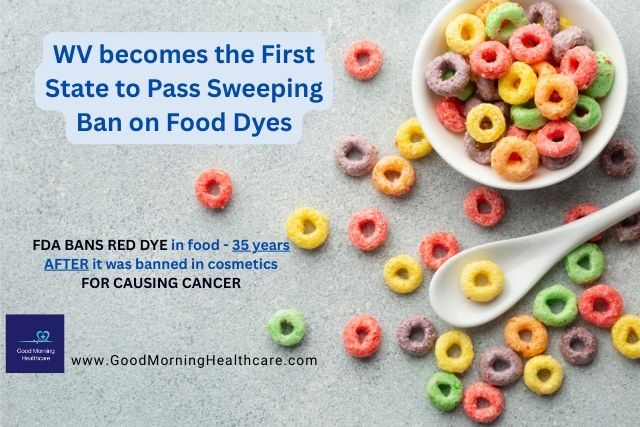West Virginia became the first state in the US to pass a comprehensive ban on the sale of food products containing certain artificial food dyes and preservatives.
In late March, Governor Patrick Morrisey signed House Bill 2354 into law, which prohibits certain harmful food dyes in school lunches and unhealthy food items for sale in West Virginia.
The law lists the following seven food dyes as unsafe and prohibits their use as an ingredient in any meal served in a school nutrition program beginning August 1, 2025:
- Red Dye No. 3
- Red Dye No. 40
- Yellow Dye No. 5
- Yellow Dye No. 6
- Blue Dye No. 1
- Blue Dye No. 2
- Green Dye No. 3

These dyes show up in many everyday foods even if you don’t realize it. Red No. 40, for example, can be found in salami, Yellow No. 6 in chicken bouillon and Blue No. 1 in canned peas.
Starting Aug. 1, these dyes will not be in school meals in the state. Starting in January 2028, the dyes, along with preservatives butylated hydroxyanisole and propylparaben, will not be allowed in any foods, beverages or over-the-counter drugs sold in the state.
This extended 2028 deadline allows companies plenty of time to adjust and follow the law while also protecting consumers from price increases.
“West Virginia ranks at the bottom of many public health metrics, which is why there’s no better place to lead the Make America Healthy Again mission,” said Governor Morrisey.
“By eliminating harmful chemicals from our food, we’re taking steps toward improving the health of our residents and protecting our children from significant long-term health and learning challenges.”
In 1990, the US Food and Drug Administration (FDA) banned Red Dye No. 3 in topical drugs and cosmetics when the FDA itself determined that the dye causes cancer when eaten by animals.
After thirty-five years, in January 2025, the FDA finally banned Red Dye No. 3 from foods, beverages, oral drugs, and dietary supplements. Some experts call this a regulatory failure.
Food additives like dyes are very common in ultra-processed foods, which usually pack in a lot more calories in smaller amounts of food compared to minimal and unprocessed foods.
“At the very least, these additives are markers of ultra-processing, which we know makes people eat more without realizing they are taking in a lot more calories,” according to Marion Nestle, a professor emerita of nutrition, food studies and public health at New York University.
Last year, California was the first state to ban food dyes in school meals and food sold on campuses certain food dyes, effective in 2027.
If you want to limit dye intake, experts say to read the labels.
“People think that ‘I know which foods have dyes and which don’t,’ but no you do not. White foods can contain dyes, foods marketed as healthy and natural can contain dyes, egg noodles can contain dyes, it’s just very hard to know and avoid them, unless you look at the label,” said environmental health consultant Lisa Lefferts.

Thank you, You will be automatically subscribed to the our newsletter.